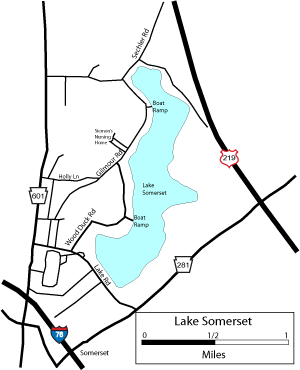
| Somerset |
| DESCRIPTION: Lake Somerset is perhaps Somerset County's premier accessible birding spot for waterbird migration. The fertile, shallow, 200-acre PFBC lake is located just east of PA 601 as it goes north out of the town of Somerset. Viewing spots include the southerly dam breast, a mid-lake boat launch on the west side, a small open area across from Siemon's Nursing Home, and a northern boat launch at the shallow upper end. |
DIRECTIONS: From the intersection of PA 601 and the entrance to the PA Turnpike, go north on PA 601 for 0.5 mile and turn right (east) on Lake Road. Go 0.25 mile and turn left (north) on Wood Duck Road. Go 0.5 mile to the boat launching area on the right and scan the lake. Continue north on Wood Duck Road At 0.35 mile, turn right on Gilmour Road. Continue for 0.42 mile to the next boat launching area. Sometimes Wood Duck Road is gated at the north end, in which case, return to Lake Road, turn right (west) and take the first road to the right (Miller Road) to a left/right turn combination to Gilmour Road and continue to the boat launching area. The best time is from ice-out in late February or March to mid April, although October to December can yield nice counts (if you go on Sunday or the time between duck hunting seasons). Most springs see fallout days with thousands of waterfowl. Both loons, Pied-billed, Horned and occasionally Red-necked grebes, occasional scoters, yearly Long-tailed Duck, good counts of all diving ducks (including hundreds of Ruddy Duck), as well as all the puddle ducks can be found. Double-crested Cormorant may linger into summer. While Ring-billed and Bonaparte's gulls are the most numerous, there are a few Herring Gull and the chance of a local rarity. Great Black-backed, Laughing, and Franklin's gulls, and Black-legged Kittiwake have been found. Caspian, Forster's, Common, and Black terns are yearly visitors. Huge flocks of swallows occur in spring and late summer in bad weather. Hawks of several species and the occasional Bald Eagle can be seen soaring over the water. An active Osprey nest in a cove on the west side of the lake is visible from the middle boat launch. Sunny spring mornings can yield many migrant and breeding warblers, vireos, flycatchers, and orioles. In years when the lake has been drawn down or there has been a drought, sand bars are exposed at the north end that can attract sandpipers. Yellowlegs, peeps, and Semipalmated Plover have been joined by more unusual local species such as Stilt Sandpiper and Long-billed Dowitcher. Post-breeding dispersal often brings a Great Egret and there is always a chance of a rare long-legged wader. |
|
Maps - other than Google (Click on map for larger view) |
|
Sub-sites |
Photos |
| Posted: 2009-10-24 00:00:00 Updated: |
